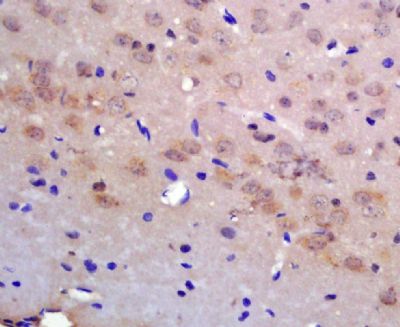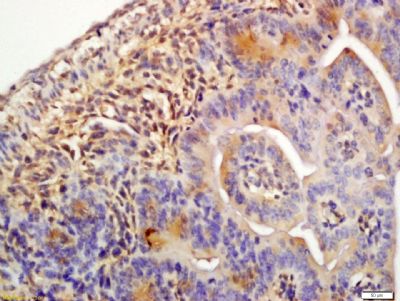英文名称: Anti-PTPRD antibody
PTPRD,酪氨酸***酸酶PTPδ抗体 蛋白酪氨酸***酸酶D受体抗体
产品编号HZ-11471R
英文名称PTPRD
中文名称酪氨酸***酸酶PTPδ抗体 蛋白酪氨酸***酸酶D受体抗体
别 名protein tyrosine phosphatase receptor type D; RPTP Delta; Tyrosine phosphatase Delta; PTPRD_HUMAN.
说 明 书0.1ml 0.2ml
研究领域细胞生物 神经生物学 信号转导 激酶和***酸酶
抗体来源Rabbit
克隆类型Polyclonal
交叉反应 Human, Mouse, Rat, Chicken, Dog, Pig, Cow, Horse, Rabbit, Sheep,
PTPRD,酪氨酸***酸酶PTPδ抗体 蛋白酪氨酸***酸酶D受体抗体产品应用WB=1:100-500 ELISA=1:500-1000 IHC-P=1:100-500 IHC-F=1:100-500 ICC=1:100-500 IF=1:100-500 (石蜡切片需做抗原修复)
not yet tested in other applications.
optimal dilutions/concentrations should be determined by the end user.
分 子 量212kDa
细胞定位细胞膜
性 状Lyophilized or Liquid
浓 度1mg/1ml
免 疫 原KLH conjugated synthetic peptide derived from human PTPRD (783-830aa)
亚 型IgG
纯化方法affinity purified by Protein A
储 存 液0.01M TBS(pH7.4) with 1% BSA, 0.03% Proclin300 and 50% Glycerol.
保存条件Store at -20 °C for one year. Avoid repeated freeze/thaw cycles. The lyophilized antibody is stable at room temperature for at least one month and for greater than a year when kept at -20°C. When reconstituted in sterile pH 7.4 0.01M PBS or diluent of antibody the antibody is stable for at least two weeks at 2-4 °C.
PTPRD,酪氨酸***酸酶PTPδ抗体 蛋白酪氨酸***酸酶D受体抗体PubMedPubMed
产品介绍background:
RelevancePTPRD is a protein tyrosine phosphatase that falls into the receptor-type group as it characteristically comprises an extracellular region, a single transmembrane region and two tandem cytoplasmic catalytic domains. The extracellular region of this protein contains 3 Ig-like and 8 fibronectin type III-like domains. This protein is thought to be involved in promoting neurite growth and in axonal guidance.
Subunit:
Interacts with IL1RAPL1 (via extracellular region); interaction is required for IL1RAPL1-mediated synapse formation (By similarity). Interacts with PPFIA1, PPFIA2 and PPFIA3.
Subcellular Location:
Membrane; Single-pass type I membrane protein.
Post-translational modifications:
A cleavage occurs, separating the extracellular domain from the transmembrane segment. This process called 'ectodomain shedding' is thought to be involved in receptor desensitization, signal transduction and/or membrane localization.
Similarity:
Belongs to the protein-tyrosine phosphatase family. Receptor class 2A subfamily.
Contains 8 fibronectin type-III domains.
Contains 3 Ig-like C2-type (immunoglobulin-like) domains.
Contains 2 tyrosine-protein phosphatase domains.
PTPRD,酪氨酸***酸酶PTPδ抗体 蛋白酪氨酸***酸酶D受体抗体Database links:
UniProtKB/Swiss-Prot: P23468.2
Important Note:
This product as supplied is intended for research use only, not for use in human, therapeutic or diagnostic applications.

